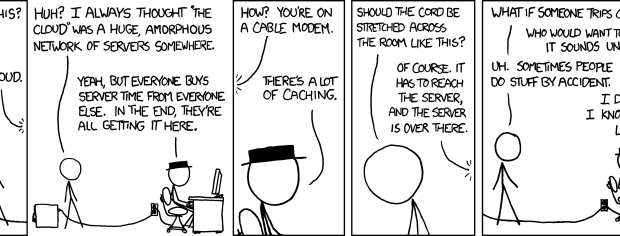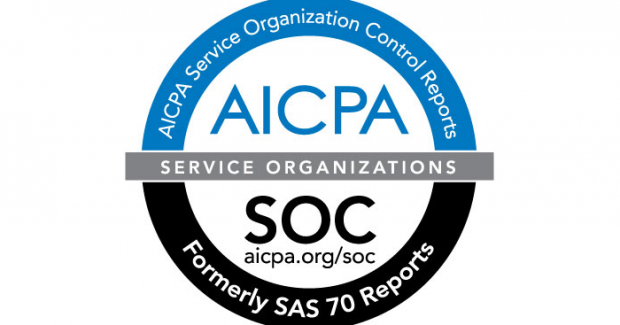October 26, 2015
by Pierre-Luc Dion
Wolverine is one of the most awesome superheroes in the Marvel Universe. It’s not because of his fierceness, the fact that he’s Canadian, or the fact that he has indestructible metal claws coming out of his fists. It’s because no matter what happens to him, no matter what harm he endures, he has a healing factor that lets him come back and continue to fight, time and time again. Wolverine can push bullets out from his wounds to heal, or regenerate from an atomic blast if he has to. He is the ultimate example of resilience and a metaphor for what you want in a cloud application — a...
Continued
October 7, 2015
by Pierre-Luc Dion
Image credit: XKCD
What happened?
Amazon Web Services experienced a service disruption for 8 hours and 33 minutes on Sunday, September 20, 2015, from 2:19 AM PDT to 10:52 AM PDT. The outage, which affected its US-EAST–1 North Virginia location, began with a network disruption that significantly increased error rates on Amazon’s DynamoDB (NoSQL database) service. This led to a cascade whereby some 37 other AWS services would begin to falter and show increased error rates for API requests.
Among these were the AWS SQS (Simple Queue Service), EC2 (Elastic Compute Cloud), CloudWatch (resource...
Continued
October 7, 2015
by Pierre-Luc Dion
Image credit: XKCD
What happened?
Amazon Web Services experienced a service disruption for 8 hours and 33 minutes on Sunday, September 20, 2015, from 2:19 AM PDT to 10:52 AM PDT. The outage, which affected its US-EAST–1 North Virginia location, began with a network disruption that significantly increased error rates on Amazon’s DynamoDB (NoSQL database) service. This led to a cascade whereby some 37 other AWS services would begin to falter and show increased error rates for API requests.
Among these were the AWS SQS (Simple Queue Service), EC2 (Elastic Compute Cloud), CloudWatch (resource...
Continued
August 12, 2015
by Pierre-Luc Dion
cloud.ca, Canada’s cloud Infrastructure as a Service (IaaS), has earned its SOC 2 type 1 certification.
The American Institute of Certified Public Accountants created the SOC (Service Organization Control) reporting platform in order to streamline reporting on accounting practices. While SOC 1 compliance covers business and financial policies, SOC 2 is designed to understand internal controls at a service organization as it relates to the newly instituted Trust Service Principles (TSPs): security, availability, processing integrity, confidentiality and privacy.
SOC 2 compliance is...
Continued
July 27, 2015
by Pierre-Luc Dion
Renewable energy has been the hot topic in the cloud industry lately. Data centres for big players like Amazon Web Services (AWS), Microsoft and Google require a lot of power, and I mean a LOT of power. One data centre consumes the equivalent energy of about 25,000 homes per year. Data centres are major sources of energy consumption and there is growing pressure on companies to be more socially responsible and to operate sustainably.
The essence of cloud computing is environmentally friendly; it allows businesses to use and pay for the right amount of IT resources at the right time, rather...
Continued
July 17, 2015
by Pierre-Luc Dion
!CloudOps has been helping companies leverage the power of cloud services for nearly as long as cloud services have been around. We were early adopters and evangelists of AWS and open source cloud technologies such as OpenStack, CloudStack and Docker. We understood the value of API-driven, self-service scalable infrastructure, and so did our customers. However, as the industry matured, we kept getting the same question: can I do this in Canada?
For many years the answer was a resounding “no”. And so we built cloud.ca, a regional IaaS and leading contender in the next wave of cloud...
Continued
July 3, 2015
by Pierre-Luc Dion
Image credit: Jessica Borutski
Recent European Union data protection regulation is pushing clouds back to the new world.
10 ms away from the Patriot Act
Many of the early adopters of our Canadian IaaS, cloud.ca, were organizations that write software and want to run it inside Canadian legal jurisdiction because they or their customers prefer Canada’s laws for data protection and data privacy. Many of our clients want to use both Amazon Web Services (AWS) and cloud.ca, depending on which customers (American or non-American) they are serving. We believe Canada is a great location for...
Continued
June 12, 2015
by Pierre-Luc Dion
CloudOps is often asked to provide proposals for organizations migrating to cloud IaaS from their local or self-managed physical servers by people very experienced with virtualization, SANs and dedicated servers. Questions frequently come up about what level of RAID we use in cloud storage and how long it takes to increase the storage amount available to a server. There is also concern with using network storage, as it is perceived to be slower.
Our answers surprise people, and upset their beliefs.
Our cloud IaaS offers a network block storage service that provides the redundancy, performance...
Continued
June 2, 2015
by Pierre-Luc Dion
Earlier this month a CloudOps team attended Citrix Synergy in Orlando, FL. For those of you who aren’t familiar with it, it’s a three day event for Citrix partners and customers focused on enterprise mobility, not to mention a great place to network and have a bit of fun.
As a gold partner, we have attended this event many times but this was our first year as a sponsor in the cloud infrastructure pavilion. We were there to promote cloud.ca, a Citrix Ready Canadian IaaS, that can support end-user compute workloads. We had lots of attendees come by our booth to learn about how...
Continued
May 19, 2015
by Pierre-Luc Dion
Previously, I blogged about differences between hosting and cloud on cloudops.com. To continue with the theme of contrasting Infrastructure as a Service (IaaS) cloud to things that are often confused with cloud, in this post I will compare IaaS cloud to virtualization. First off, SaaS can run on cloud, but is not cloud. I am strictly referring to an IaaS cloud.
Cloud is an operational model
I suggest we agree to use the NIST definition for cloud computing. Adopting the technology is not enough. Cloud technology needs to be adopted in a way that allows the users to self-serve. At cloud.ca, we...
Continued









